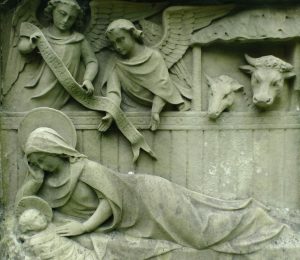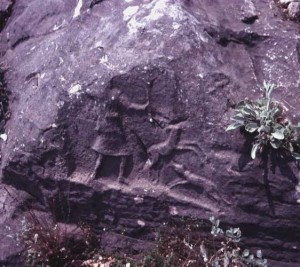In previous posts (Trinities; When Early Christians Revered a Female Deity; Trials and Tribulations of Translating Scripture 2; and The Feminine/Androgynous Jesus), we have dealt to some extent with Mary, the mother of Jesus (also known in Christian tradition as the Virgin Mary or the Mother of God). We have seen that, although there is not much information about Mary in the New Testament, her reputation grew over time, to the extent that she was worshipped as a deity in her own right in some areas and is still highly revered by millions of the faithful around the world. Compelling visions of Mary at Fatima, Lourdes, Medjugorje and elsewhere continue to inspire pilgrims from all walks of life.
Most of what we “know” about Mary comes from apocryphal writings, that is, Christian literature that circulated in the first few centuries but was not included in the New Testament. Here we will look at Mary from the perspective of depictions in “apocryphal” or “extra-canonical” Christian art – that is, art derived from these non-Biblical sources, both oral and written. This art constitutes a relatively new source of material evidence for women in antiquity, female personifications, and other female images. Through these works of art – paintings and frescoes, illuminated or illustrated manuscripts, and so on – it is possible to find important images of Mary.
Art from the early third through the sixth centuries parallels the production of the apocryphal literature. Examining this art can help us better understand the religious context at the time the art and/or stories were produced and circulated. We will be especially aided by David R. Cartlidge and J. Keith Elliott, Art and the Christian Apocrypha. We shall see that imagery of Mary was a logical outgrowth of belief and practice in the ancient world and had its roots in prehistory.
Mary Mother of Jesus
 Cartlidge and Elliott devote an entire chapter to images of the Virgin Mary as reflected in apocryphal stories. Mary was depicted in both Western and Eastern transmissions following her life cycle. Cartlidge and Elliott (page 23) state that the Mary stories came about in order “to extend the history of redemption back into the story of the mother of the Redeemer. . . . A theological impetus in the early church was to tie together the story of redemption in the history of Israel with that of the early church. . . . A connecting of the old and new covenants stands out in virtually every scene of the Marian gospels. . . [T]he story of the Virgin in her gospels has a didactic purpose, namely, to spell out the exemplary Christian life, in purity, service and fidelity.”
Cartlidge and Elliott devote an entire chapter to images of the Virgin Mary as reflected in apocryphal stories. Mary was depicted in both Western and Eastern transmissions following her life cycle. Cartlidge and Elliott (page 23) state that the Mary stories came about in order “to extend the history of redemption back into the story of the mother of the Redeemer. . . . A theological impetus in the early church was to tie together the story of redemption in the history of Israel with that of the early church. . . . A connecting of the old and new covenants stands out in virtually every scene of the Marian gospels. . . [T]he story of the Virgin in her gospels has a didactic purpose, namely, to spell out the exemplary Christian life, in purity, service and fidelity.”
In addition to this didactic purpose, there are undoubtedly others. First, the Mary cycles are very rich. They follow extra-canonical threads by moving from Mary’s parentage, to her holy and pure birth, to her life in the temple, to her marriage. The canonical story then continues with Mary’s bearing of Jesus and her mourning at his death. The apocryphal material then picks up with her death (dormition) and assumption into heaven. Many of these stages, as Cartlidge and Elliott reveal, are depicted artistically, not only in the first Christian centuries but through the Middle Ages.
The Mary and Jesus story, however, did not develop in a vacuum but rather in the context of pagan mythology and folklore. As early as prehistoric times, the all-powerful female deity was tripartite (three-fold): maiden, mother, crone. The life cycle of the Virgin Mary continues this trend (with one major difference being that the crone is usually depicted as ugly, while Mary’s death is beautiful and fragrant): Mary is maiden, mother and older woman. What may be reflected in the Mary life cycles is the church’s attempt (or perhaps some female Christians’ attempt) to depict Mary as similar to but better than the old tripartite goddess. The dissemination of the Mary cycles may have attracted goddess-worshipping people, especially women, to the Christ cult. 
Cartlidge and Elliott suggest additional underlying purposes behind these stories of Mary. First, “virgins living in a temple” recall the Vestal Virgins at Rome, whose lives were dedicated to preserving and protecting the city. The church, perhaps especially the church at Rome, had to determine how to insert the savior god of pagan tradition into the church’s story while preserving a protective image of the virgins. Thus they developed the notion that Mary remained perpetually virginal even while becoming a mother. This idea would not necessarily have been foreign to ancient people: they would have been able to hold the two supposed opposites in tension.
Second, in some texts Virgin Mary embroiders while living at the temple, and in others she is chosen to weave the veil of the temple. (Some of these texts included Pseudo-Matthew , the Gospel of the Nativity of Mary and Protevangelium [Gospel] of James.) Weaving and similar tasks are traditionally associated with goddesses (and human females; see especially Gimbutas, Language, 68-69). According to Barbara Walker in The Women’s Encyclopedia of Myths and Secrets, the Three Fates were the Moerae, or “Marys, who spun the thread of destiny.” While this juxtaposition may seem fanciful to us, some early Christians were in all likelihood quite familiar with the tradition of Mary spinning, weaving or embroidering in the temple or at home before Jesus’ birth. Moira, from Greek religion, signifies “divine power determining the individual’s fate.” Thus equating three Marys with Three Fates or Moerae would have been one way that some pagans understood the Mary figures.
Also, in Greek myth, the invention of all arts, including spinning and weaving, was attributed to Athena, a Greek version of much earlier goddess figures of great power. From evidence collected by archaeologists and anthropologists at prehistoric sites throughout Europe and the Middle East, it is clear that it was a deity in female form who was the object of greatest devotion; this adoration may have existed for as long as 100,000 years, according to Gimbutas. This deity did not just disappear at the dawn of the historical period when male gods became ascendant; rather, she was transformed into the female deities with which we and our Christian ancestors are and were very familiar – Artemis, Demeter, Athena, Hera, Aphrodite, Bona Dea, Isis, Hekate, and others.
In Provence in the south of France, there is a wonderful fifth-century drawing of Mary standing in the orans (praying) position and preaching in the Temple; this non-canonical portrayal, published in Cartlidge and Elliott, Christian Apocrypha, 38, may well illustrate a cultic reality: women and men worshipping Mary as goddess, priest, preacher. With all that Mary traditionally did and stood for through the ages, she was not often shown in this stance. The humble handmaid of the Lord had become a leader.
Yet this too had its origin in fact. Mary was venerated as a goddess at certain times and places, to the consternation of early church fathers. By the fourth century, Bishop Epiphanius of Salamis in Cyprus (315-403 CE) was ordering the faithful not to worship Mary but only the Father, Son and Holy Spirit, suggesting that the worship of Mary in her own right had been transpiring for awhile (Walker, Encyclopedia, 603). It was also Epiphanius who condemned the Collyridian sect in one of his writings; according to him, this sect originated in Thrace and was composed primarily of women who sacrificed cakes to Mary in a possible parallel to the cult of Ceres (Demeter) or Artemis (Diana). Epiphanius betrays his misogyny in another document when he exclaims, “For who should it be that teach thus but women? For the race of women is slippery, fallible, and humble-minded.” He goes on to explain the difference between Mary being worthy of veneration and worthy of actual worship: “Yea, verily, the body of Mary was holy, but was surely not God. Verily, the Virgin was a virgin, and was honoured, but was not given to us to worship.”
The existence of the Collyridian sect, the proscription of Epiphanius and others against the actual worship of Mary, and the extra-canonical portrayal of Mary preaching in the temple are highly significant. The Collyridians may have lasted for as long as 100 years, between 350 and 450 CE. This strongly suggests the existence of a Mary of great power and influence. In the Graeco-Roman context, this is common and telling: the powerful female figure, the mother, would not have been unusual but rather normative and meaningful. Mary meek and mild was only one possible interpretation of the Virgin for early Christians; for others she was undoubtedly the powerful mother goddess who gave and sustained life for all creation.
Conclusion
The art of the Christian apocrypha is ripe for interpretation and can aid us in further exploring early Christianity in all its manifestations. The images of Mary, other women, and female personifications shed even further light on early Christianity.
These apocryphal images demonstrate that imagining the Divine in female form was very much alive in the first Christian centuries. Mary the Virgin, the mother of Jesus, the mother of God, the God-bearer, whose story was almost exclusively told outside the Biblical canon, met needs of people that a male Jesus alone could not meet. Obviously many of the images died out over time – due to lack of official support, a waning of significance for believers, the growth of alternative symbols, iconoclasm. Eventually, church leaders banned the actual worship of Mary and used the stories of female saints to encourage (if not compel) real women to submit to the will of a male God, not to think or act independently and not to function as priests.
However, the images and stories showing strong, autonomous women and all-powerful female deities, into the post-Constantinian era, shows the dynamic at work – a struggle to attract converts to the faith, in the midst of goddesses and female images, while promoting male deities and limiting female autonomy. It seems highly unlikely that pagans accustomed to appealing to female deities would have converted willingly to Christianity unless they were allowed (or encouraged, or given the opportunity) to contemplate Christian images in female form.
In many ways, then, the success of the Jesus movement would have been impossible without female images, their agency as strong, life-giving human beings (or deities), and the acknowledgment of their invaluable contributions to the salvation of the world. In addition to Biblical images and stories, devotees appealed to apocryphal stories. Women and female images, then, were not marginal to the early Christian movement but rather, especially for Gentile converts, essential.
Resources
Abrahamsen, Valerie. “Female Imagery in Christian Apocryphal Art,” Journal of Higher Criticism, Vol. 12, No. 1 (Spring 2006) 1-16.
Abrahamsen, Valerie A. Goddess and God: A Holy Tension in the First Christian Centuries. Marco Polo Monographs 10. Warren Center, PA: Shangri-La Publications, 2006.
Cartlidge, David R. and J. Keith Elliott. Art and the Christian Apocrypha. London and New York: Routledge, 2001, especially pages 21-46.
Gimbutas, Marija. The Language of the Goddess. San Francisco: Harper and Row, Publishers, 1989.
Walker, Barbara G. The Woman’s Encyclopedia of Myths and Secrets. San Francisco: Harper and Row, 1983.

